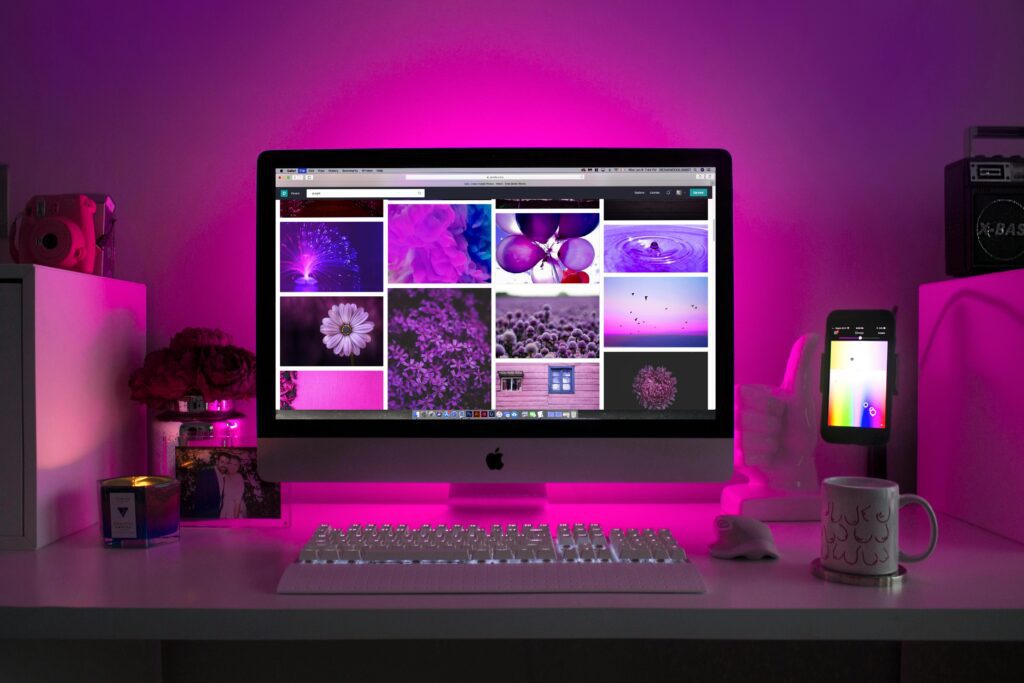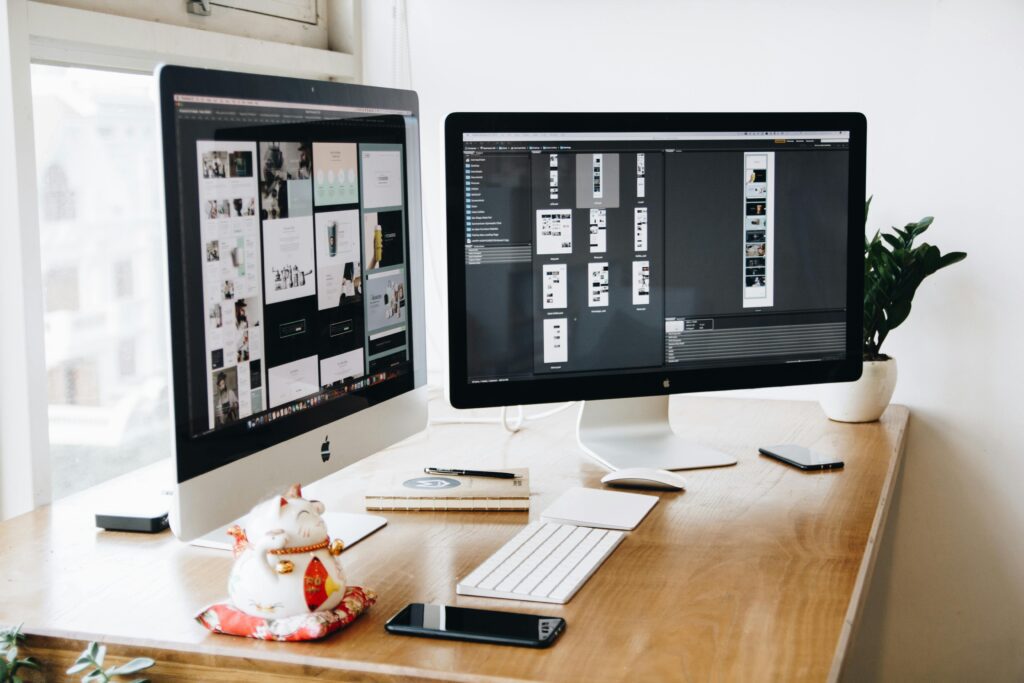If you’re a working filmmaker, you need a website. When I was first given this piece of advice, I wasn’t happy about it, but I knew it was true. After all, what do you do if you want to learn more about a person? If you want to see more of their work? If you want to hire them? The first thing you do is Google their name or the name of their company. And, as a filmmaker, you want the very first thing that pops up to be your website. A website helps you build connections and get gigs, after all. But if you’re not an experienced professional, you’re probably going to need some filmmaker web design tips. That’s where we come in. Now, I’m not a web designer; I can’t teach you even the basics of coding or design. But I can talk to you about my experience with building my personal website, and give good tips for filmmakers looking to DIY their own site!
Without further ado, let’s dive into my top filmmaker web design tips!

#1: Choose your platform.
Choosing your platform should be your first step. There are tons of websites out there that allow you to build a beautiful website yourself, but before you select one, you need to be familiar with your options. Some of the bigger services include WordPress, Wix, Squarespace, Weebly, and GoDaddy. I’m not going to give you the pros and cons of each service, because depending on your needs and budget limitations, what works best for me might not work best for you. I’m just going to say you should research each of these options before deciding, and at the bare minimum you should understand the price points, design options, and usability of each service. I personally chose WordPress for my personal website because of the cost, the user experience, and the templates that were available, but that doesn’t mean it’s the right fit for you and your website.
A word of caution; once you’ve invested time and money into your website and built it, it’s harder to pivot to another service if you’re unhappy with the user experience, so really do your research here. I can’t tell you how many artists I know who just chose the first option they saw and then, weeks or months later, wanted to switch services but either couldn’t afford to or didn’t have the time to build a whole new website from scratch. Do yourself a favor and make a choice you’re confident in! Youtube has a ton of videos about each option, so take advantage of those resources.
#2: Know what you want… but stay flexible.
This next filmmaker web design tip might seem straightforward. As a filmmaker, I’m going to go out on a limb and guess that you have a strong aesthetic point of view and an eye for beautiful things. But don’t just start browsing templates on vibes. Take the time to look at the websites of other filmmakers you admire, particularly other indie filmmakers who may have similar budgets to you. Think about your brand and the story you want to tell with your filmmaking website. If you don’t have a brand kit, read this article and then get back to work on the site. Do you want to showcase your beautiful cinematography with a video reel? Do you want to have a blog? Should the vibe of your website be dark and moody, or do you want something more playful and approachable? Think about what you need to communicate, as well as what your user experience will be. At the bare minimum, I recommend having an about me section that goes into detail about you and your work, a page for videos and still photographs to act as your reel, an opportunity to share some of the brands you’ve already worked with, and a place for people to contact you. Other things, like a blog or a storefront, are fully optional, but should definitely be considered.
A moment of tough love: don’t break your own heart by going to A24’s website and saying “I want that.” If you’re new to this and you’re DIYing your own website, that just isn’t going to be possible. Even if you’re hiring a professional and investing a lot of money, chances are your budget is not the same as A24’s, and that’s okay. You are going to walk away from this with a beautiful, professional-looking website, and the truth is, you don’t need a website that makes you look like someone else. If your website looks like you and your brand, the right clients and industry connections will find you.
It’s important to stay flexible during this brainstorming process. When I built my own website, I had a very clear idea of what I wanted, and then was disappointed in myself when I couldn’t pull it off. In hindsight, it was silly, because all I really needed was a website that effectively communicated who I am and what I do. Instead of creating a picture of exactly what you want the site to look like, brainstorm in broad strokes. Think about colors, shapes, functions, and feelings instead of trying to pinpoint something super specific. Have a vision, but stay flexible, and remember that just because you build a website one way today doesn’t mean you can’t totally redo it tomorrow. That’s a major upside to DIYing your site; you can always tweak it by yourself if you’re unhappy.
#3: See what’s available.
If you’re totally new to building a website, like I was, I’m going to recommend you use a template. Most of the major website building services have templates that were created by real designers. Some are free and some are paid. You should familiarize yourself with what’s out there before selecting one. Take your time and really browse through the options, keeping in mind that you can always tweak things like colors, fonts, and even layouts. For my website, I picked a layout I liked, changed the colors to suit my brand, found a photo that resonated with me on Pexels.com, and then all I had to do was upload my copy and my headshot. Easy!
While you’re browsing through templates, think about the function your website is going to serve. You probably want a contact form so that potential clients and collaborators can get in touch with you easily. If you sell digital products like LUTs, do you need a storefront? Does the template have a blog? Remember, it’s much easier to delete pages you don’t want than to build a page you need.
If you’re not seeing what you want on the actual site, expand your search. Many people don’t know that you can buy website themes or templates on sites like Etsy, but it’s actually a great resource! Some of them are pricey, but a lot are in the $30 range, and the great news is that, unlike hosting services, your theme/template is a one-time purchase. If you’re able to invest a little more, I highly recommend it. If you’re super happy with your site, you’re less likely to have to spend time and money tweaking it down the line. Just make sure you feel good about whatever you pick!

#4: Write your copy.
You know what’s just as important as your website design? The actual text that’s on the site. Maybe my most vital filmmaker web design tip is that you need to think very carefully about the words you use to express yourself to the people who visit your site. If you’re looking for potential clients, you need to clearly communicate who you are, what you want to be doing, and why they should hire you. If you’re looking to connect with collaborators, your copy should make you look like a great person to collaborate with, clearly explaining your background and your values. If an investor or distributor is looking at your site, you want to make sure your copy convinces them that you’re worth betting on.
Copywriting is a separate skill from other forms of writing. Just because you can write a killer screenplay doesn’t mean you’re sure to know how to sell yourself. I recommend taking the time to learn a little bit about the craft of copywriting, how it’s different from other forms of writing, and how you can create an amazing hook and land your dream client. Once again, Youtube is a great resource for this. Watch a few videos and then see what you can do with those tips in mind. While you’re writing, don’t forget about your own voice, and try to match the vibe of the website you’ve been envisioning. And don’t forget to brag! This is your chance to make yourself seem like a big deal, which you totally are. Share your accomplishments, broadcast your awards and festival laurels, talk about your specific skill set. I am begging you to not be modest here. You’re an amazing filmmaker and the world needs to know about it! Even if you’re just getting started, you have things to brag about, I promise.
#5: Put it all together.
You’ve determined what you want, what service you want to use, what’s possible, and the actual content for your site. All that’s left to do is put it all together! Take some time to install your theme, buy your domain name, tweak details like colors and fonts, upload your badass reel, insert your copy… I don’t want to say it’s easy or simple, because for most services there’s a bit of a learning curve, but I feel confident in saying that if you’ve done your homework you can throw this all together in an afternoon.
As you work, think about the user experience. What’s the first thing you want your visitors to see? Do you want them to watch your reel the second they land on your site? Do you want them to learn about you, your values, and your experience before they see any of your work? Is your headshot going to be front and center? Where do you want behind the scenes photos to go?
Take the time to tweak everything until you’re happy with it. Don’t be afraid to pause and look up tutorials if you’re feeling overwhelmed, or contact the support team if you’re really stumped! Once again, I want to remind you that you’re going to need to compromise, and a DIY website is probably not going to look the same as a website that costs a lot of money, but that doesn’t mean you won’t be able to create something you’re proud of. You want to look professional, and you want to sell yourself, but most of that is going to come from things like your reel or the copy you already worked so hard on. Take a deep breath, give yourself some grace, and put it all together!
There we have it, my top five filmmaker web design tips. I hope these were helpful, and good luck with your new website! If you use these tips, send me a link to your site, I’d love to see it!

Leave a Reply